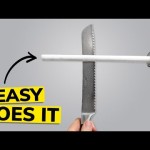
89805e1d123d9d48db8ce095ba0ec8cc
Sharpening knives is an important skill for any chef or home cook. It is essential to keep your knives sharp and in good condition to ensure that they are safe and effective to use. One of the most popular methods of sharpening knives is using a whetstone. Whetstones come in a variety of grits, and it is important to understand the differences between them in order to choose the right one for your needs. In this article, we will discuss the different types of whetstone grits and how to choose the right one for sharpening your knives.
What is the difference between 1000 grit and 6000 grit whetstone
Sharpening knives is an important part of kitchen maintenance. A whetstone is a great tool for sharpening knives, and there are many different types of whetstones available. Two of the most common types are 1000 grit and 6000 grit whetstones.
The grit of a whetstone refers to the size of the abrasive particles on the stone. The higher the grit, the finer the abrasive particles. A 1000 grit whetstone has larger abrasive particles than a 6000 grit whetstone. This means that a 1000 grit whetstone is better for removing material from the blade, while a 6000 grit whetstone is better for polishing and honing the blade.
When using a 1000 grit whetstone, it is important to use a light touch and to keep the blade moving. This will help to prevent the blade from becoming damaged. A 1000 grit whetstone is also best used for knives that are very dull or have nicks in the blade. The larger abrasive particles will help to remove these imperfections.
A 6000 grit whetstone is best used for knives that are already sharp. The finer abrasive particles will help to polish and hone the blade, giving it a sharper edge. It is important to use a light touch when using a 6000 grit whetstone, as too much pressure can damage the blade.
In conclusion, 1000 grit and 6000 grit whetstones are both useful tools for sharpening knives. A 1000 grit whetstone is best used for removing material from the blade, while a 6000 grit whetstone is best used for polishing and honing the blade. It is important to use a light touch when using either type of whetstone, as too much pressure can damage the blade.
Which is finer 1000 grit or 6000 grit
When it comes to sandpaper, the higher the grit number, the finer the abrasive. This means that 6000 grit is finer than 1000 grit. The difference between the two is quite significant, as 1000 grit is considered a coarse sandpaper, while 6000 grit is considered a very fine sandpaper.
1000 grit sandpaper is used for heavy sanding and removing material quickly. It is often used for removing rust, paint, and other materials from metal surfaces. It is also used for sanding down wood surfaces to prepare them for staining or painting. 1000 grit sandpaper is not suitable for finishing work, as it leaves behind a rough surface.
6000 grit sandpaper is used for finishing work. It is used to create a smooth, polished surface on wood, metal, and other materials. It is also used for polishing and buffing surfaces. 6000 grit sandpaper is not suitable for heavy sanding or removing material, as it is too fine for that purpose.
In conclusion, 6000 grit is finer than 1000 grit. 1000 grit is used for heavy sanding and removing material, while 6000 grit is used for finishing work and creating a smooth, polished surface.
Both types of sandpaper have their uses, and it is important to choose the right one for the job.
What size grit is best for knife sharpening
Sharpening a knife is an important part of knife maintenance. It is important to use the right size grit when sharpening a knife to ensure that the blade is sharpened properly. The size of the grit used for sharpening a knife will depend on the type of knife and the desired sharpness.
Coarse Grit – Coarse grit is typically used for knives that are very dull or have nicks in the blade. Coarse grit will remove a lot of material from the blade quickly, making it ideal for restoring a dull blade. Coarse grit is usually in the range of 80-120 grit.
Medium Grit – Medium grit is used for knives that are not too dull but need some sharpening. Medium grit will remove some material from the blade but not as much as coarse grit. Medium grit is usually in the range of 150-220 grit.
Fine Grit – Fine grit is used for knives that are already sharp but need to be honed. Fine grit will remove very little material from the blade and will help to refine the edge. Fine grit is usually in the range of 240-600 grit.
The size of the grit used for sharpening a knife will depend on the type of knife and the desired sharpness. Coarse grit is best for knives that are very dull or have nicks in the blade, while medium grit is best for knives that are not too dull but need some sharpening. Fine grit is best for knives that are already sharp but need to be honed. It is important to use the right size grit when sharpening a knife to ensure that the blade is sharpened properly.
What are the different grits of whetstones
A whetstone is a tool used to sharpen blades and tools. It is made of a hard abrasive material, usually a form of quartz, and is used to sharpen blades by grinding away the metal. Whetstones come in a variety of grits, which refer to the size of the abrasive particles on the stone. The higher the grit, the finer the abrasive particles and the smoother the finish on the blade.
Coarse Grit – Coarse grit whetstones are typically used for sharpening dull blades or for removing nicks and chips from the blade. Coarse grit stones range from 80 to 220 grit.
Medium Grit – Medium grit whetstones are used for general sharpening of blades. Medium grit stones range from 220 to 400 grit.
Fine Grit – Fine grit whetstones are used for honing and polishing blades. Fine grit stones range from 400 to 1000 grit.
Ultra-Fine Grit – Ultra-fine grit whetstones are used for polishing and finishing blades. Ultra-fine grit stones range from 1000 to 3000 grit.
When choosing a whetstone, it is important to consider the type of blade you are sharpening and the desired finish. Coarse grit stones are best for dull blades, while fine and ultra-fine grit stones are best for honing and polishing blades. It is also important to remember that the higher the grit, the finer the abrasive particles and the smoother the finish on the blade.
Thank you for taking the time to read this article about understanding whetstone grits for sharpening knives. We hope that you now have a better understanding of the different grits and how to use them. Goodbye and have a great day!















